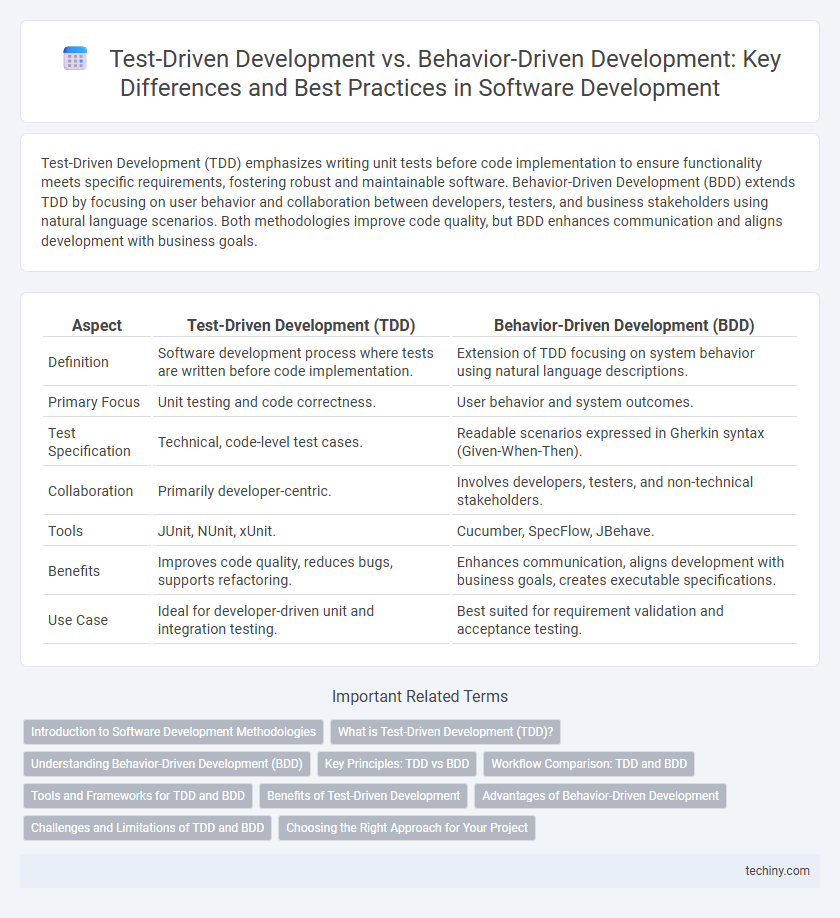Test-Driven Development (TDD) emphasizes writing unit tests before code implementation to ensure functionality meets specific requirements, fostering robust and maintainable software. Behavior-Driven Development (BDD) extends TDD by focusing on user behavior and collaboration between developers, testers, and business stakeholders using natural language scenarios. Both methodologies improve code quality, but BDD enhances communication and aligns development with business goals.
Table of Comparison
| Aspect | Test-Driven Development (TDD) | Behavior-Driven Development (BDD) |
|---|---|---|
| Definition | Software development process where tests are written before code implementation. | Extension of TDD focusing on system behavior using natural language descriptions. |
| Primary Focus | Unit testing and code correctness. | User behavior and system outcomes. |
| Test Specification | Technical, code-level test cases. | Readable scenarios expressed in Gherkin syntax (Given-When-Then). |
| Collaboration | Primarily developer-centric. | Involves developers, testers, and non-technical stakeholders. |
| Tools | JUnit, NUnit, xUnit. | Cucumber, SpecFlow, JBehave. |
| Benefits | Improves code quality, reduces bugs, supports refactoring. | Enhances communication, aligns development with business goals, creates executable specifications. |
| Use Case | Ideal for developer-driven unit and integration testing. | Best suited for requirement validation and acceptance testing. |
Introduction to Software Development Methodologies
Test-Driven Development (TDD) emphasizes writing unit tests before code implementation to ensure functionality meets specified requirements, enhancing code reliability and maintainability. Behavior-Driven Development (BDD) extends TDD by focusing on system behavior through user-centric scenarios described in natural language, improving collaboration between developers, testers, and business stakeholders. Both methodologies are integral to modern Agile software development workflows, promoting iterative progress and continuous integration.
What is Test-Driven Development (TDD)?
Test-Driven Development (TDD) is a software development methodology where developers write automated test cases before writing the actual code, ensuring functionality meets predefined requirements. This approach emphasizes small, incremental code changes supported by continuous testing, leading to higher code quality and easier maintenance. TDD helps detect defects early, promotes simple design, and provides a clear specification through test cases that drive development.
Understanding Behavior-Driven Development (BDD)
Behavior-Driven Development (BDD) emphasizes collaboration between developers, testers, and non-technical stakeholders by using natural language descriptions to define software behavior. It extends Test-Driven Development (TDD) by focusing on the expected outcomes of functionality through executable specifications written in frameworks like Cucumber or SpecFlow. BDD improves communication, ensures alignment on requirements, and produces more maintainable automated tests that reflect real-world user scenarios.
Key Principles: TDD vs BDD
Test-Driven Development (TDD) centers on writing unit tests before actual code, emphasizing code correctness and design through repetitive cycles of testing and coding. Behavior-Driven Development (BDD) extends TDD by incorporating natural language descriptions of software behavior, fostering collaboration between developers, testers, and non-technical stakeholders. TDD prioritizes technical correctness while BDD emphasizes clear communication and shared understanding of software requirements.
Workflow Comparison: TDD and BDD
Test-Driven Development (TDD) follows a strict cycle of writing failing unit tests before implementing code, emphasizing small, incremental improvements with immediate feedback. Behavior-Driven Development (BDD) extends this workflow by incorporating collaboration between developers, testers, and business stakeholders using human-readable specifications and scenarios. Both workflows enhance software quality but differ in scope: TDD targets low-level functionality while BDD focuses on validating system behavior through shared understanding.
Tools and Frameworks for TDD and BDD
Test-Driven Development (TDD) commonly utilizes frameworks like JUnit for Java, NUnit for .NET, and pytest for Python to write unit tests that drive code design. Behavior-Driven Development (BDD) relies on tools such as Cucumber, SpecFlow, and Behave, which support creating human-readable scenarios that bridge communication between developers and non-technical stakeholders. Both TDD and BDD frameworks integrate with continuous integration systems like Jenkins and CircleCI to ensure automated testing throughout the development lifecycle.
Benefits of Test-Driven Development
Test-Driven Development (TDD) enhances code quality by enforcing rigorous testing before implementation, leading to fewer defects and more maintainable software. It promotes modular design and improves developer confidence through immediate feedback on code correctness. TDD facilitates faster debugging and reduces overall development time by catching issues early in the development cycle.
Advantages of Behavior-Driven Development
Behavior-Driven Development (BDD) enhances collaboration between developers, testers, and non-technical stakeholders by using natural language scenarios that improve communication and ensure shared understanding of requirements. BDD facilitates early defect detection and reduces rework through clear, executable specifications that directly link business objectives to test cases. This approach also supports more maintainable and scalable test suites by promoting modular and reusable test scripts aligned with user behaviors.
Challenges and Limitations of TDD and BDD
Test-Driven Development (TDD) often faces challenges such as difficulty in writing exhaustive tests for complex business logic and maintaining test code as the application evolves, which can slow down development velocity. Behavior-Driven Development (BDD) struggles with ambiguity in defining clear, testable behavior scenarios and requires strong collaboration across cross-functional teams, making it resource-intensive and sometimes hard to scale. Both methodologies demand a cultural shift and rigorous discipline, which can hinder adoption in organizations unfamiliar with continuous testing practices.
Choosing the Right Approach for Your Project
Choosing the right approach between Test-Driven Development (TDD) and Behavior-Driven Development (BDD) depends on project requirements and stakeholder collaboration. TDD emphasizes writing unit tests before code to ensure functionality, making it ideal for technical teams focused on code correctness and low-level testing. BDD fosters communication between developers, testers, and business stakeholders through natural language scenarios, improving clarity on user behaviors and acceptance criteria for projects prioritizing user experience and cross-team alignment.
Test-Driven Development vs Behavior-Driven Development Infographic

 techiny.com
techiny.com